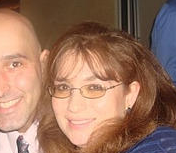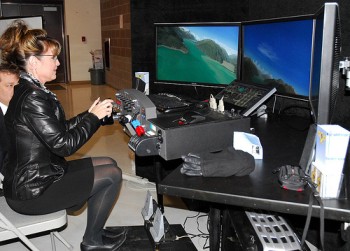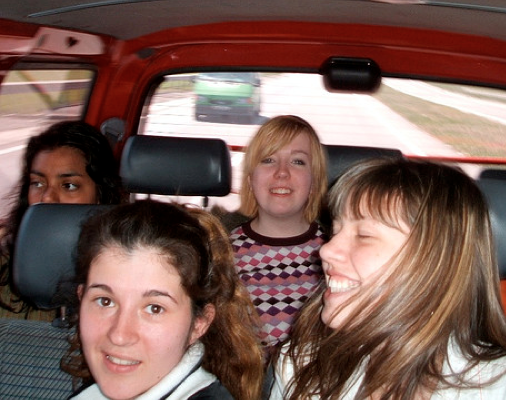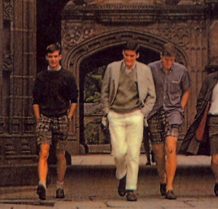American Empathy Watch: When Suicide Jumpers Destroy Our Cars

“A New Jersey woman is devastated that her precious sports car — just repaired and fully gassed up — was wrecked by a suicidal man’s 40-story attempted death leap on the Upper West Side…. “I miss it. It’s my baby,” moaned Maria McCormack… ‘Why? Why my car out of all the cars in the city?’…. Meanwhile, a Dodge spokesman credited the car’s ‘high-strength steel structure’ for helping absorb the blow.” Really, everyone comes out a winner in this one.
How Sarah Palin Ruined Alaska
by Marty Beckerman

The new Vanity Fair Sarah Palin profile is enthralling: rage-fueled breakdowns, domestic violence (is there a battered spouse center for First Dudes?) and Madoff-worthy financial manipulation. Equally fascinating is the climate of fear and confusion that Michael Joseph Gross discovered in Wasilla, where townspeople are terrified of discussing their former mayor/governor, and deeply uncomfortable with the world-famous media creation that she has become. “To appreciate how alien Palin has become in Wasilla, how inscrutable to her own people, you have to wrap your mind around the fact that Sarah Palin is more famous than any other Alaskan, ever,” Gross writes. “It still does not quite seem real to most Alaskans that there are all these thousands of people in the Lower 48 turning out for … Sarah.”
But if they want surreal, they should travel to the Lower 48. Because it’s not until you leave Alaska that you realize it no longer exists — only Sarah Palin exists.
Born and raised in Anchorage, I caught rainbow trout before learning multiplication tables; I camped outside in the middle of winter with my Cub Scout troop; and I once heroically saved my dog (a friendly 135-pound Newfoundland) from an (unfriendly 1,000-or-so-pound) moose. It wasn’t strange to me that the sun barely set half the year and barely rose half the year, or that enormous snow-capped mountains surrounded our cityscape-it’s just how the world looked. But at college in D.C. I’d get asked every day, as if I were from some exotic fantasy land: “Did you mush dogs instead of driving a car?” “Did your family live in an igloo?” “Did you have a pet polar bear?”
No, no, and no, but I loved these asinine, naive, wonderful questions. Saying “I’m from Alaska” was the best conversation starter imaginable, and on countless occasions instantly made me the most interesting person in the room unless there was someone around from, like, Tanzania. (Fun factoid: Jewel used to yodel in the hallways of my high school.)
But it was never the same after August 29, 2008. As soon as John McCain picked Sarah Palin as his VP candidate, suddenly no one asked about months of darkness or snowboarding to school-only about her. Whenever I boasted of my birthplace to new acquaintances, expecting to become the glorious center of attention yet again, I instead became some random guy indistinguishably whining about politics. Nobody cared anymore. And to this day, nobody cares-it’s been two years since anyone asked about gearshifts on dogsleds. Like it or not, America’s most hideous politician has ruined America’s most beautiful state.
Palin doesn’t merely represent the Alaskan archetype in the national consciousness; she is Alaska. The rest of us are stars in her constellation, fish in her sea, decapitated trophies mounted on her cabin wall. I’ll always be proud of my homeland, but if I reveal this to strangers I get snide, collective punishment responses such as “I hate your state!” (Seriously… maybe I should spend more time in Real America instead of at NYC media cocktail hours?) Whereas Alaska used to enter my every conversation, I now rarely bring it up-if I’ve had enough whiskey and someone asks, I’ll grimace and mutter “Palin country.”
But as much as I’d like to avoid the subject, I’m probably stuck with it forever. Recently, while I had my hair cut in the East Village, the immigrant barber asked where I’m from.
“Alaska?” he replied in a thick Russian accent. “I used to see it from my house.”
Marty Beckerman is the author of Generation S.L.U.T.
and Dumbocracy, and online features editor at Esquire.
Photo by asecondhandconjecture, from Flickr.
America's Adopted Koreans, Part 2: When Adoption Became Visible
by Sarah Idzik

Adoption is not often discussed, even-maybe especially-among adoptees. My brother was also adopted, two years after me, and until last week, we had never talked about it, not even once. While conducting interviews for this series, I received some responses that were telling-and not just because they were answers to questions I had asked. “I hope this kinda answers your questions. They were very hard to answer,” one interviewee said. Another: “Sorry it took me so long. I didn’t realize how hard it was going to be.” A third person said: “I’m glad I’m not insane and there are people who really do feel like there are a thousand issues they need to deal with.”
Their responses mirror the reaction I had when I first read this article about Korean adoptees, which was, in short: oh! I’m not actually alone!
To understand why this is, it helps to consider how we came to be here in the first place. Unlike most other racial and ethnic groups in the U.S., we didn’t immigrate here, nor were we brought here for slavery or servitude. A 34-year-old adoptee from central Illinois who asked to be identified as Barry gave the example of African-Americans, who were originally brought to this country to be “slaves in the name of economic progress,” while “Koreans were shipped to America to save us from Our Horrible Circumstance in the name of American altruism.” And unlike Americans of African descent, who still struggle to overcome negative racial narratives and America’s history with slavery, “we’ve assimilated, and we’re seen as productive/accepted naturalized American citizens, but the underlying issues of cultural identification still linger as a result.”
Rachel, an adoptee who’s also from my small Pittsburgh suburb hometown, said that she feels the key difference between her experience and that of non-adoptee Asian-Americans is that she never experienced “‘the struggle’ of parents making it here.”
And unlike other groups who established themselves in this country after first being passionately loathed and oppressed, Korean adoptees do not have a well-defined, built-in community to rely on. We are both widely dispersed and thoroughly assimilated, and so in a way, we are each alone.
According to the Evan B. Donaldson Adoption Institute’s 2009 study [PDF] on adoptees and cultural identity, early adoptions attempted to “match” children with parents in both physical appearance and temperament, “in large part to make adoption invisible.” And though the rise in transracial and transnational adoption necessarily made adoption more “visible,” it was generally thought that in order to “support the development of positive identity,” it usually sufficed to have the devotion of loving adoptive parents and some education in the child’s native culture.
As Steve, a Nashville-dwelling adoptee born around 1974 and adopted in 1976, put it: “It used to be assimilation or- well, let’s just talk about assimilation.” But as the Adoption Institute study says, “[S]ociety’s practice of international and transracial adoption has advanced far more quickly than has the understanding of how to best promote identity development for these individuals and their families.”
In other words, America’s participation in the industry of adoption outpaced our ability to deal with the identity-related consequences.
“It isn’t just a cold cut ‘my mother gave me up so I have issues’ and ‘you’re white and I’m yellow and I have issues.’ It’s layer after layer after layer,” said Rachel. “It’s like my entire identity is stuck in limbo.”
Steve said that for him, identity wasn’t an issue until he was in 7th grade, when 16 Candles came out. “That’s the year I became Long Duk Dong,” he said. “And Getty Watanabe became the most hated man in my world.” To him, the mocking of his classmates “felt like complete betrayal.”
“I think I felt like I was the same as everyone around me. I mean, the kids who were suddenly taunting me had been my friends for as long as I could remember,” he said. After his Great Betrayal, Steve took on a “punk rock skater kid” persona, going peroxide blonde, dressing strangely, and taking an interest in obscure bands “for the purpose of putting my classmates off.” He started to become more comfortable with his identity as he reached adulthood, but only after “many years and many bad poems,” including poetry addressed to a nonexistent brother. “Longing for a kindred spirit?” I asked him. “For a blood relative,” Steve said.
Steve isn’t alone in having experienced this kind of longing. Longing seems to be a common characteristic among adoptees. Adoptees may long for a lot of things: sense of belonging, connection with their heritage, connection with their birth mothers.
As Caroline, a 24-year-old adoptee from Oklahoma, said, “It seems to me that as adoptees we do a lot of searching. Searching for who we are, searching for ways to fit in, searching for our birth families, and the list can go on and on. I sometimes find myself thinking that maybe I need to stop searching. Maybe I just need to be satisfied with what I have, with who I am.”
And as Rebecca, an adoptee from Wisconsin, pointed out to me, there is also a more specific kind of yearning very unique to adoptees: “I had to relearn my culture and am still learning about it. I envy those with Korean parents because the Korean culture is instilled in them from their parents and grandparents around them. It has been a struggle to find who I am and where exactly I fit in.”
No matter how thorough their assimilation (Caroline even said that she didn’t remember “having the so-called ‘identity crisis’ as a kid”), there is often a sense that something is missing, or that something is very different, and that this separates them from their fellow American-born peers, and from other non-adopted Asian-Americans as well.
Many were taught, to greater or lesser degrees, about Korean culture as children. And every adoptee I spoke with said that they knew from a very young age that they were adopted. But while there are plenty of ways to introduce a child’s birth culture into his or her upbringing, they often backfire. “I was part of an adoption group when I was younger, but I was like seven and it was just an excuse for the kids to get together and eat ice cream,” Rachel said.
When Rebecca was little, her mother would take her to a Korean church, but that didn’t last because it was difficult for her mother to attend an all-Korean service.
Steve’s parents took him and his adopted sister to annual adoptee picnics, which he did enjoy. He made friends, saying that “it felt good, in a way that was hard to understand at the time, to be around lots of other adopted Korean kids,” and he appreciated his parents’ efforts to introduce him to his heritage-until 16 Candles. After that, when his mom suggested a Korean language class, Steve balked. “She thought would be a great idea, probably because it would have been,” he said. “But I said no way. I was at a point where I didn’t want to miss out on my weekend football game to learn a language none of my friends could speak anyway. Or to differentiate myself from my friends that way.”
Maybe it’s the idealism of American society that causes us to harbor the implicit belief that adoptees have been assimilated so thoroughly that they won’t have identity issues twenty years or more down the line. And many adoptees don’t feel that their situation is that complex-and others don’t register any complexity until, say, a fellow adoptee comes around asking a bunch of questions.
The phenomenon of assimilation contributed to Barry choosing the term “domesticated” as the best way to describe the Korean-American adoptee experience, though he recognizes how bad it sounds. “I can’t muster any hostility towards my parents, the adoption system, America, or anyone else,” he said. “Everyone’s intentions were altruistic, and I really can’t complain about the outcome. It’s just so frustrating.” He acknowledged that compared to the struggles of other ethnic and racial groups in the U.S., the less clearly defined problems of adoptees may seem “minor or superficial,” but even this doubt seems to be the consequence of the blueprint-less nature of the adoptee experience. There are no recent historical precedents with which to compare or validate an individual’s feelings.
In many foreign countries, including South Korea, adoption-even domestic adoption-is very rarely discussed because of the shame attributed to the act. In cultures that place high value on family bloodlines, adoption is frequently hidden and kept secret. In the U.S., it’s often the opposite. Currently we try to embrace nontraditional families so fully that adoptees become “invisible” in an entirely different way. The impulse to strenuously treat everyone equally can sometimes leave no room for actual discussion.
“I have friends who either say, ‘Who cares? Why does it bother you so much?’ or they literally do not understand how one person could have so many issues,” Rachel said.
Sarah Idzik is a writer living in Chicago. She is really into not being alone.
Photo from Flickr by marktristan.
American Poet To Legally Change His Name To "American Poetry"
Our poet friend Jim Behrle has had enough (of some toxic substance). “Since I’ve pretty much burned through the good name my parents gave me, I’ve decided this is as good a time as ever to legally change my name to ‘American Poetry.’”
The Fantasy Constructions of MoDo
I thought Maureen Dowd was on vacation all summer. But I was just forgetting to look. Now I’m glad about that.
Public Sector Workers: Angels Or Scumbags?
Are people who take lower salaries to do public service work noble, self-sacrificing examplars of mankind’s charitable spirit or sanctimonious pricks sucking at the teat of the state and expecting a thank you for it? Or both? I guess they could be both. Anyway, there are some opinions here.
Take That, Ivy! Made-Up Corporate Identity Lingers at Jack Spade

“Outside the Jack Spade store were some bicycles, restored just enough to let you know they’d been restored. Next to them was a sign in the window: ‘Vintage bikes for sale. Please inquire within. Signed, Jack Spade.’”
-The ghost of the former owner’s character Jack Spade still haunts Liz Claiborne’s Jack Spade store.
Order Your Drink In A Short Glass

Researchers have discovered that people tend to pour more generous measures of spirits when using short, wide tumblers rather than tall slender glasses. Choosing the wrong shaped glass can lead to drinkers consuming almost twice as much alcohol, the researchers from Oxford University found…. [T]he study by leading psychologist Professor Charles Spence also found that people drink 88 per cent more when using a short wide glasses compared to a taller glass containing the same amount of alcohol. In the study even veteran bartenders poured 26 per cent more alcohol into tumblers than highball glasses.
This discovery will have profound implications on the way in which I deal with bartenders. It’s almost autumn and now I learn this? My life is about to change in marvelous ways. If you could see me now you would be looking at a man grinning from ear to ear (and drooling a bit). Professor Charles Spence, you, sir, are a hero. And I, my friends, am off.
